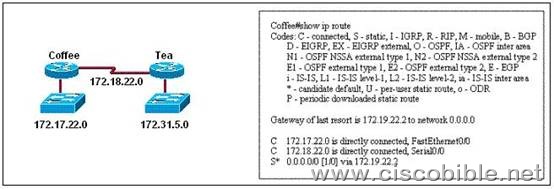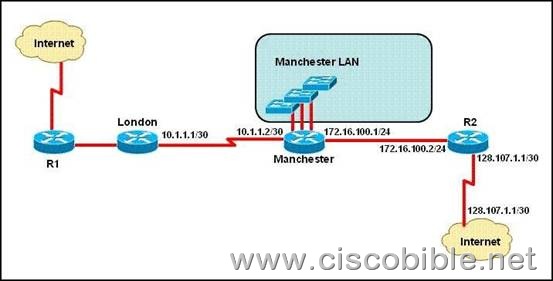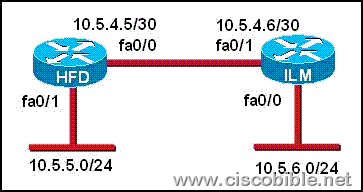1. The network administrator of the Oregon router adds the following command to the router configuration: ip route 192.168.12.0 255.255.255.0 172.16.12.1. What are the results of adding this command? (Choose two.)
A:The command establishes a static route.
B:The command invokes a dynamic routing protocol for 192.168.12.0.
C:Traffic for network 192.168.12.0 is forwarded to 172.16.12.1.
D:Traffic for all networks is forwarded to 172.16.12.1.
E:This route is automatically propagated throughout the entire network.
F:Traffic for network 172.16.12.0 is forwarded to the 192.168.12.0 network.
Correct Answers: A, C
Explanation:
In order to configure a static route the router has to be in global configuration mode.
ip route network prefix mask {address | interface} [distance]
network – the destination network
mask – is the subnet mask for that network
address – IP address of the next hop router
interface – or the interface the traffic is to leave by
distance – (optional) the administrative distance of the route
2. Users on the 172.17.22.0 network cannot reach the server located on the 172.31.5.0 network. The network administrator connected to router Coffee via the console port, issued the show ip route command, and was able to ping the server. Based on the output of the show ip route command and the topology shown in the graphic, what is the cause of the failure?
A: The network has not fully converged.
B: IP routing is not enabled.
C: A static route is configured incorrectly.
D: The FastEthernet interface on Coffee is disabled.
E: The neighbor relationship table is not correctly updated.
F: The routing table on Coffee has not updated .
Correct Answers: C
Explanation:
On the bottom line of the command output for ‘show ip route’ you can see that there is an asterisk by the letter S. The S stands for static route, and the static route is incorrectly configured.
3. Refer to the exhibit. The speed of all serial links is E1 and the speed of all Ethernet links is 100 Mb/s. A static route will be established on the Manchester router to direct traffic toward the Internet over the most direct path available. What configuration on the Manchester router will establish a route toward the Internet for traffic that originates from workstations on the Manchester LAN?
A: ip route 0.0.0.0 255.255.255.0 172.16.100.2
B: ip route 0.0.0.0 0.0.0.0 128.107.1.1
C: ip route 0.0.0.0 255.255.255.252 128.107.1.1
D: ip route 0.0.0.0 0.0.0.0 172.16.100.1
E: ip route 0.0.0.0 0.0.0.0 172.16.100.2
F: ip route 0.0.0.0 255.255.255.255 172.16.100.2
Correct Answers: E
Explanation:
We use default routing to send packets with a remote destination network not in the routing table to the next-hop router. You should generally only use default routing on stub networks-those with only one exit path out of the network.
According to exhibit, all traffic towards Internet that originates from workstations should forward to R2 Router.
Syntax for default route is:
ip route <Remote_Network> <Netmask> <Next_Hop_Address>.
4. Some of the routers have been configured with default routes. What are some of the advantages of using default routes?(Choose two.)
A:They establish routes that will never go down.
B:The keep routing tables small.
C:They require a great deal of CPU power.
D:The allow connectivity to remote networks that are not in the routing table.
E:They direct traffic from the Internet into corporate networks.
Correct Answers: B, D
Explanation:
Routers use default routing as a last resort when all other methods (directly connected, static, or dynamic) have been exhausted. For stub networks, a single default static route could be used to provide connectivity to the entire network. This is desirable for stub networks where only a single link connects the remote location to the rest of the networks. Because all of the traffic only has one link to use, a single default route will make the routing table as small as possible, while providing for connectivity to networks not in the routing table, since as traffic destined for the Internet.
5. Refer to the graphic. A static route to the 10.5.6.0/24 network is to be configured on the HFD router. Which commands will accomplish this? (Choose two.)
A. HFD(config)# ip route 10.5.6.0 0.0.0.255 fa0/0
B. HFD(config)# ip route 10.5.6.0 0.0.0.255 10.5.4.6
C. HFD(config)# ip route 10.5.6.0 255.255.255.0 fa0/0
D. HFD(config)# ip route 10.5.6.0 255.255.255.0 10.5.4.6
E. HFD(config)# ip route 10.5.4.6 0.0.0.255 10.5.6.0
F. HFD(config)# ip route 10.5.4.6 255.255.255.0 10.5.6.0
Answer: CD








